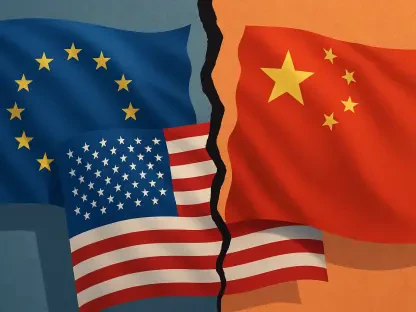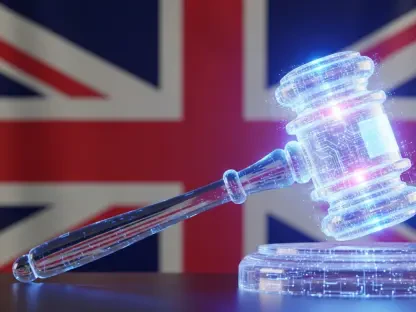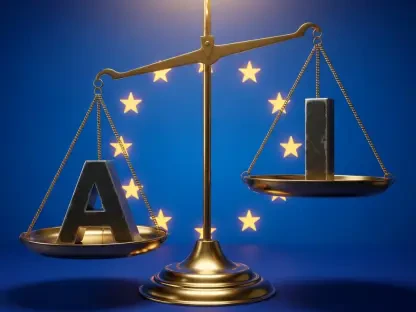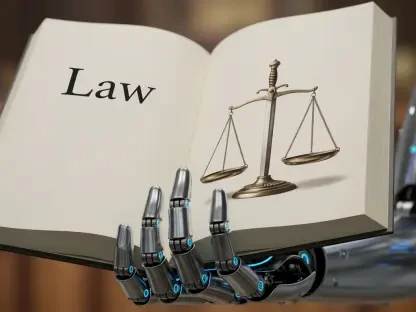Overview of the Industry Landscape
Imagine a digital world where the rules of engagement are fiercely contested, with global powers battling over the balance between freedom and control, a reality that defines the current tech industry. This conflict has come to a head as the Trump administration locks horns with the European Union over the Digital Services Act (DSA), a sweeping regulation designed to enhance online safety. The DSA targets illegal content such as hate speech, aiming to create a safer internet for millions of users across Europe. Yet, this initiative has sparked a transatlantic feud, with accusations of censorship flying from the US side while the EU defends its stance as a vital protective measure.
The tech sector, a cornerstone of the global economy, finds itself at the heart of this dispute. Major American tech companies, EU regulators, and high-ranking US officials are key players in a conflict that could reshape how digital platforms operate worldwide. The DSA’s scope is vast, imposing strict compliance requirements on platforms to monitor and remove harmful content, which has led to tensions over its perceived impact on free expression. This clash represents not just a policy disagreement but a fundamental divide in how technology should be governed on a global scale.
In-Depth Analysis of the Conflict
Deepening Divide in US-EU Tech Regulation Approaches
Philosophical Underpinnings of the Dispute
At the core of this transatlantic rift lies a stark contrast in ideology regarding tech governance. The US, under the Trump administration, champions a hands-off approach, prioritizing free speech and minimal regulatory interference to foster innovation. In contrast, the EU places a premium on user safety and platform accountability, arguing that unchecked digital spaces pose significant risks to society. This philosophical split has created palpable tension, as each side views the other’s policies as misguided or even harmful to the digital ecosystem.
Criticism from US officials has been sharp and pointed. Figures such as Secretary of State Marco Rubio and Vice President JD Vance have publicly decried the DSA, claiming it disproportionately silences conservative voices and unfairly targets American tech giants. They argue that the EU’s regulations infringe on fundamental rights and create an uneven playing field for US businesses. This narrative has fueled a broader discourse on whether the EU’s approach constitutes overreach or a necessary evolution in managing online spaces.
Current Tensions and Risks of Escalation
The Trump administration has not minced words in its opposition, with internal discussions focusing on potential retaliatory measures against the EU. Options such as sanctions or visa restrictions for EU officials enforcing the DSA have been floated, signaling a readiness to escalate the conflict. While no final decisions have been made, the mere consideration of such actions underscores the severity of the disagreement and the potential for a significant deterioration in US-EU relations.
The implications of this standoff extend beyond rhetoric, as any punitive measures could disrupt diplomatic and economic ties. The tech industry, already navigating a complex global regulatory landscape, faces the prospect of further uncertainty if these threats materialize. Both sides appear entrenched, with the EU steadfast in defending the DSA as a balanced framework, raising questions about how this deadlock might be resolved without lasting damage to transatlantic cooperation.
Challenges and Regulatory Burdens of the DSA
The DSA imposes substantial challenges for American tech companies operating in the European market. Compliance with the act requires significant investments in risk assessments, content moderation systems, and reporting mechanisms, driving up operational costs. Non-compliance carries hefty penalties, with fines reaching up to six percent of a company’s global revenue, a figure that could cripple even the largest tech firms if enforced.
From the perspective of the Trump administration, these regulations represent an unacceptable burden that stifles innovation and restricts free expression. The view from Washington is that the EU is overstepping its bounds, imposing rules that hinder the competitive edge of American businesses. This sentiment has led to calls for pushback, with some US policymakers advocating for legal challenges or diplomatic negotiations to lessen the impact of the DSA on domestic companies.
Efforts to mitigate these challenges are underway, though progress remains slow. Potential strategies include bilateral talks to carve out exemptions or adjustments for American firms, as well as leveraging international trade agreements to address perceived inequities. However, the path forward is fraught with complexity, as the EU shows little inclination to dilute its regulatory framework, leaving tech companies caught in the crossfire of this geopolitical struggle.
Impact of the DSA on AI Services and Emerging Platforms
A critical dimension of the DSA’s reach is its potential application to AI providers, with platforms like OpenAI’s ChatGPT under scrutiny. As of the latest data, ChatGPT Search stands at 41.3 million monthly active users in the EU, inching closer to the 45 million threshold for designation as a “very large online platform” (VLOP). Should it cross this line, the platform would face stringent obligations, including risk assessments on disinformation, independent audits, and data access for researchers.
These requirements are compounded by the complementary EU AI Act, which introduces additional layers of regulation specific to AI models. Together, these frameworks create a dual regulatory burden that could significantly impact how AI services operate and scale within the European market. The prospect of fines and operational constraints raises concerns among industry stakeholders about the feasibility of compliance without sacrificing innovation.
The broader implications for AI development are profound, as stricter rules could slow the pace of technological advancement or drive companies to prioritize markets with lighter oversight. For emerging platforms, the DSA and AI Act signal a future where regulatory hurdles are a constant factor in strategic planning. This evolving landscape underscores the need for adaptive approaches to balance compliance with the drive to push technological boundaries.
Future Implications for US-EU Relations and Tech Governance
Looking ahead, the ongoing conflict over the DSA could have lasting repercussions for US-EU relations, particularly in the economic sphere. If tensions escalate to the point of tariffs or trade disputes, the tech industry could face collateral damage, with ripple effects on global supply chains and market dynamics. The stakes are high, as both regions are pivotal to the digital economy, and any disruption could reshape competitive landscapes.
Emerging trends in tech regulation point to increasing scrutiny of AI and digital platforms, a development that will likely intensify the divergence between US and EU approaches. While the US leans toward fostering innovation through deregulation, the EU’s focus on safety and accountability could set a precedent for other regions, potentially influencing global standards. This dynamic raises critical questions about whether a unified framework for tech governance is achievable in such a polarized environment.
Factors such as diplomatic dialogue and economic conditions will play a decisive role in shaping the outcome of this dispute. Collaborative efforts to address shared concerns, like disinformation and cyber threats, could pave the way for compromise. However, without a willingness to bridge ideological gaps, the risk of prolonged friction remains, casting a shadow over the future of transatlantic tech cooperation.
Reflections and Path Forward
The clash between the Trump administration and the EU over the Digital Services Act unfolded as a defining moment in the tech industry, highlighting deep-seated differences in regulatory philosophy. This dispute, marked by accusations of censorship and defenses of user safety, revealed the challenges of aligning diverse perspectives in a rapidly evolving digital landscape. The potential expansion of the DSA to AI services further amplified the stakes, as companies grappled with unprecedented compliance demands.
Moving forward, actionable steps emerged as essential to navigate this complex terrain. Establishing regular high-level dialogues between US and EU officials could foster mutual understanding and identify areas for compromise. Additionally, creating a joint task force to explore harmonized tech governance standards offered a practical avenue to reduce friction. Encouraging industry input in these discussions ensured that policies reflected real-world operational realities, paving the way for balanced solutions.
Ultimately, the resolution of this conflict hinged on a shared commitment to innovation and security. Exploring flexible frameworks that accommodated both free speech and user protection stood out as a promising direction. As the tech sector continued to evolve, the lessons from this episode underscored the importance of adaptability and collaboration in addressing the global challenges of the digital age.









